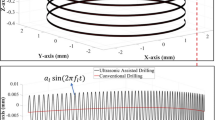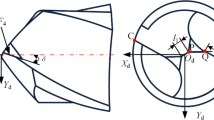Abstract
Drilling of titanium alloy results in considerable burrs at the exit surface of a hole. The burrs deteriorate quality of hole surfaces and can cause misalignment during assembly. Therefore, burr minimization while drilling is necessary. In this study, innovative chamfered drills with slits have been developed to reduce the burr height and thrust forces. Dry drilling experiments were conducted using chamfered drills without slits and with slits (CWS) having four different point angles. Drilling performance was measured in terms of burr height, thrust forces, and chips morphology. A finite element method-based model was developed to simulate drilling of Ti6Al4V alloy using the drills without and with slits. The results show that the maximum burr height for CWS drills was reduced by 48.5% as compared to the conventional drills. The thrust forces were reduced by 5.5% and were in a fair agreement with the simulation results. For most of the cases, the simulated forces were within 10% of their experimental counterparts.
















Similar content being viewed by others
Abbreviations
- CWOS:
-
Chamfered drill without slits
- CWS:
-
Chamfered drill with slits
- \( F_{{{\text{t}}\_{\text{wos}}}} \) :
-
Thrust force with chamfered drill without slits
- \( F_{{{\text{t}}\_{\text{ws}}}} \) :
-
Thrust force with chamfered drill with slits
- \( h_{{\_{\text{wos}}}} \) :
-
Burr height with chamfered drill without slits
- \( h_{{\_{\text{ws}}}} \) :
-
Burr height with chamfered drill with slits
References
Davim J P (Ed.) Machining of titanium alloys, Springer, Berlin, Heidelberg (2014) p 2.
Klocke F, Settineri L, Lung, Priarone P C and Arft M, Wear 302 (2013) 1136.
Abdelhafeez A M, Soo S L, Aspinwall D K, Dowson A and Arnold D, Procedia CIRP 37 (2015) 230.
Zhang P F, Churi N J, Pei Z J and Treadwell C, Mach Sci Technol, 12 (2008) 417.
Yunming Z, Guicheng W and Lei W, IEEE Int Conf Intell Syst Des Eng Appl 2 (2010) 369.
Aurich J C, Dornfeld D, Arrazola P J, Franke V, Leitz L, and Min S, CIRP Ann 58 (2009) 519.
Ko S L, Lee J K, J Mater Process Technol 113 (2001) 392.
Manickam C and Parthipan N, Mater Today Proc (2019) (in Press) https://doi.org/10.1016/j.matpr.2019.07.589.
Dornfeld D A, Strategies for preventing and minimizing burr formation, LMA Research Reports, University of California, Berkeley (2003).
Kim J, Min S and Dornfeld D A, Int J Mach Tools ManufInt J Mach Tools Manuf, 41 (2001) 923.
Dornfeld D A, Kim J S, Dechow H, Hewson J, Chen L J, CIRP Ann Manuf Technol, 48 (1999) 73.
Joy N, Prakash S, Krishnamoorthy A and Antony A. Mater Today Proc (2019) (in Press). https://doi.org/10.1016/j.matpr.2019.05.458.
Ko S L, Chang J E and Yang G E, J Mater Process Technol, 140 (2003) 237.
Karnik S R and Gaitonde V N, Int J Adv Manuf Technol, 39 (2008) 439.
Stein J M and Dornfeld D A, CIRP Ann, 46 (1997), 63.
Kilickap E, Int J Adv Manuf Technol, 49 (2010) 911.
Alonso U, Calamaz M, Girot F and Iriondo E, J Manuf Process, 39 (2019) 356.
Mathew N T and Vijayaraghavan L, J Manuf Process, 24 (2016) 256.
Patil R, Shinde S, Marla D and Joshi S, Int J Mechatron Manuf Syst, 9 (2016) 237.
Version A 6.13 Documentation (Abaqus), Abaqus user’s guide (2013).
Johnson G R and Cook W H, in Proceedings of the 7th International Symposium on Ballistics. The Hague, Netherlands: International Ballistics Committee (1983) p 541.
Johnson G R and Cook W H, Eng Fract Mech 21 (1985) 31.
Hillerborg A, Modeer M and Petersson P E, Cem Concr Res 6 (1976) 773.
Li A Pang J Zhao J Zang J and Wang F, Int J Mech Sci, 123 (2017) 214.
Brinksmeier E and Janssen R, CIRP Ann 51 (2002) 87.
Yi S, Li G X, Ding S L, and Mo J, Key Eng Mater 730 (2017) 289.
Acknowledgement
Authors are thankful for the financial support provided by Aeronautics Research and Development Board, India (Project Number: 16ARDB002 (RD/0116-ARDB000-09-EXP.)) to carry out this research work.
Author information
Authors and Affiliations
Corresponding author
Additional information
Publisher's Note
Springer Nature remains neutral with regard to jurisdictional claims in published maps and institutional affiliations.
Appendix
Appendix
With the regression analysis, the obtained response surfaces models for the burr height using CWOS and CWS at four different drill point angle are given in Appendix (Eqs. 8–15).
where h_wos and h_ws represent the burr height for CWOS and CWS, respectively, and f denotes the feed.
With the regression analysis, the obtained response surfaces models for the thrust force using CWOS and CWS at four different drill point angle are given in Appendix (Eqs. 16–23).
where \( F_{{{\text{t\_wos}}}} \) and \( F_{{{\text{t\_ws}}}} \) represent the thrust force for CWOS and CWS, respectively, and f denotes the feed (Tables 11, 12).
Rights and permissions
About this article
Cite this article
Gajrani, K.K., Divse, V. & Joshi, S.S. Burr Reduction in Drilling Titanium using Drills with Peripheral Slits. Trans Indian Inst Met 74, 1155–1172 (2021). https://doi.org/10.1007/s12666-021-02271-0
Received:
Accepted:
Published:
Issue Date:
DOI: https://doi.org/10.1007/s12666-021-02271-0




